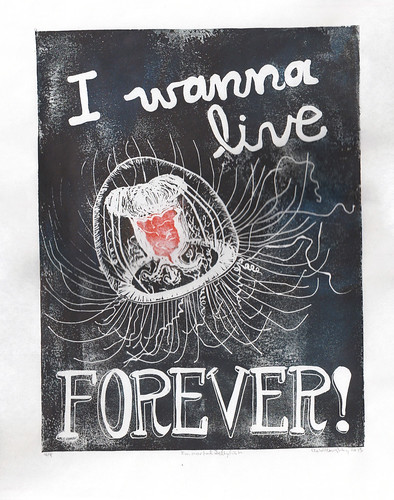 |
| Immortal Jellyfish, Ele Willoughby (c) 2015, 11" x 14" (27.9 cm x 35.6 cm) |
T. dohrnii are hydrozoans which begin life as a sort of free floating fertilized egg known as planula larvae, a sort of plankton. These settle on the seafloor and a colony of polyps, or hydroids, attached to the seafloor like a little garden of multi-branched soon-to-be-jellyfish. The jellyfish, or medusae, bud off these polyps, each a genetically identical clone to the next. The medusae swim freely until sexual maturity. After that, should the T. dohrnii face environmental stress, assault or simply age and illness, it can revert to the polyp form, found a new colony and begin again! This cycle can, in theory, repeat ad infinitum.
The "immortal jellyfish" was formerly classified as T. nutricula, which had also been confused with the similar T. rubra. It turns out that it's quite the challenge to tell one Turritopsis from another. Currently only one scientist, Shin Kubota from Kyoto University, has managed to sustain a group of these jellyfish for a prolonged period of time in captivity; in two years, his colony rebirthed itself 11 times! Wanting to avoid the mistake of confusing one Turritopsis for another, I was glad to read the New York Times Magazine profile of Shin Kubota and the Turritopsis dohrnii - so I could be confident their images were of the right animal!
Incidentally, googling "immortal jellyfish" turns up a lot of strange things, including harebrained anti-aging schemes and vampire fans.









No comments:
Post a Comment